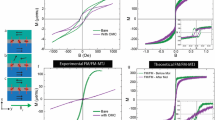Abstract
The intra-molecular coupling within multiple units of paramagnetic molecules can produce various effects on molecular spintronics devices (MSD). This paper focuses on double-segmented molecules as the device element to advance understanding of the Impact of internal molecular structure on magnetic tunnel junction-based MSD (MTJMSD). We performed Monte Carlo simulations (MCS) to fill the knowledge gap about the intramolecular coupling role in the magnetic properties of the MTJMSD. This study explored a double-segmented molecule containing two atomic sections, each with a net spin state interacting via Heisenberg exchange coupling within molecules and with ferromagnetic electrodes at different thermal energies, magnetic fields, and coupling strengths. This study also investigated the effect of magnetic field on the double-segmented molecule-based cross-junction-shaped MTJMSD. We also compared the effect of the magnetic field on the mono and double-segmented molecules when connected to two ferromagnetic electrodes. In the strong coupling regime, the intramolecular coupling and molecule coupling with the two ferromagnetic electrodes dominated the MTJMSD response near the molecular junction area. This study provides insight for evaluating the Impact of molecular nanostructure internal connectedness on the integrated MSD.
Graphical abstract





Similar content being viewed by others
Data availability
Data included in this paper is available upon reasonable request.
References
A.J. Epstein, Organic-based magnets: opportunities in photoinduced magnetism, spintronics, fractal magnetism, and beyond. MRS Bull. 28(7), 492–499 (2003)
M. Verdaguer, Rational synthesis of molecular magnetic materials: a tribute to Olivier Kahn. Polyhedron 20(11–14), 1115–1128 (2001)
L. Bogani, W. Wernsdorfer, Molecular spintronics using single-molecule magnets. Nat. Mater. 7(3), 179–186 (2008)
A. Cornia, P. Seneor, Spintronics: the molecular way. Nat. Mater. 16, 505–506 (2017)
A. Cornia, P. Seneor, The molecular way. Nat. Mater. 16(5), 505–506 (2017)
K.V. Raman, Interface-assisted molecular spintronics. Appl. Phys. Rev. 1(3), 031101 (2014)
P. Tyagi, C. Baker, C. D’Angelo, Paramagnetic molecule induced strong antiferromagnetic exchange coupling on a magnetic tunnel junction based molecular spintronics device. Nanotechnology 26(30), 305602 (2015)
G.X. Miao, M. Munzenberg, J.S. Moodera, Tunneling path toward spintronics. Rep. Prog. Phys. 74, 036501 (2011)
J.R. Petta, S.K. Slater, D.C. Ralph, Spin-dependent transport in molecular tunnel junctions. Phys. Rev. Lett. 93(13), 136601 (2004)
S. Sanvito, A.R. Rocha, Molecular-spintronics: the art of driving spin through molecules. J. Comp. Theor. Nanosci. 3(5), 624–642 (2006)
J.R. Heath, Molecular electronics. Annu. Rev. Mater. Res. 39, 1–23 (2009)
J.S. Moodera, J. Nowak, R.J.M. van de Veerdonk, Interface magnetism and spin wave scattering in ferromagnet-insulator-ferromagnet tunnel junctions. Phys. Rev. Lett. 80(13), 2941–2944 (1998)
K. Inomata et al., Highly spin-polarized materials and devices for spintronics(∗). Sci. Technol. Adv. Mater. 9(1), 014101–014101 (2008)
P. Tyagi, C. Riso, E. Friebe, Magnetic tunnel junction based molecular spintronics devices exhibiting current suppression at room temperature. Org. Electron. 64, 188–194 (2019)
P. Tyagi, C. Riso, Magnetic force microscopy revealing long range molecule impact on magnetic tunnel junction based molecular spintronics devices. Org. Electron. 75, 105421 (2019)
M. Savadkoohi et al., Impact of ferromagnetic electrode length and thickness on magnetic tunnel junction-based molecular spintronic devices (MTJMSD). Org. Electron. 102, 106429 (2022)
D.F. Li et al., An S=6 cyanide-bridged octanuclear (Fe4Ni4II)-Ni-III complex that exhibits slow relaxation of the magnetization. J. Am. Chem. Soc. 128(13), 4214–4215 (2006)
D.F. Li et al., Ancillary ligand functionalization of cyanide-bridged S = 6 FeIII4NiII4 complexes for molecule-based electronics. Inorg. Chem. 45(13), 7569 (2006)
P. Tyagi, C. Baker, C. D’Angelo, Paramagnetic molecule induced strong antiferromagnetic exchange coupling on a magnetic tunnel junction based molecular spintronics device. Nanotechnology 26(30), 305602 (2015)
P. Tyagi, C. Baker, C. D’Angelo, Paramagnetic molecule induced strong antiferromagnetic exchange coupling on a magnetic tunnel junction based molecular spintronics device. Nanotechnology 26, 305602 (2015)
P. Tyagi, C. D’Angelo, C. Baker, Monte carlo and experimental magnetic studies of molecular spintronics devices. NANO 10, 1550056 (2015)
J. Martinek et al., Kondo effect in the presence of itinerant-electron ferromagnetism studied with the numerical renormalization group method. Phys. Rev. Lett. 91(24), 247202 (2003)
A.N. Pasupathy et al., The Kondo effect in the presence of ferromagnetism. Science 306(5693), 86–89 (2004)
K. Baberschke, Why are spin wave excitations all important in nanoscale magnetism? Phys. Status Solidi A 245(1), 174–181 (2008)
Funding
We gratefully acknowledge the funding support from the National Science Foundation-CREST Award (Contract # HRD-1914751), Department of Energy/ National Nuclear Security Agency (DE-FOA-0003945), and National Aeronautics and Space Administration (NASA)/ Minority University Research and Education Project (MURP) grant (80NSSC19M0196).
Author information
Authors and Affiliations
Contributions
Pius conducted theoretical simulations using Monte Carlo Simulation Program designed for Magneti tunnel junction-based molecular device research. Marzieh, EM, BD, and CD helped analyze the simulation data. BD and EM also contributed to simulation studies. PT conducted the experimental study and contributed to data analysis and manuscript writing. CD wrote the Monte Carlo simulation code to simulate MTJMSD under the supervision and direction of Pawan. Pius analyzed the experimental and theoretical data and wrote the manuscript.
Corresponding author
Ethics declarations
Conflict of interest
The authors have no competing interests to declare that are relevant to the content of this article.
Additional information
Publisher's Note
Springer Nature remains neutral with regard to jurisdictional claims in published maps and institutional affiliations.
Supplementary Information
Below is the link to the electronic supplementary material.
Rights and permissions
Springer Nature or its licensor (e.g. a society or other partner) holds exclusive rights to this article under a publishing agreement with the author(s) or other rightsholder(s); author self-archiving of the accepted manuscript version of this article is solely governed by the terms of such publishing agreement and applicable law.
About this article
Cite this article
Suh, P.K., Grizzle, A., Mutunga, E. et al. Intra-molecular coupling within double-segmented molecules impacting magnetic tunnel junction-based molecular spintronics devices. MRS Communications 14, 103–113 (2024). https://doi.org/10.1557/s43579-023-00508-1
Received:
Accepted:
Published:
Issue Date:
DOI: https://doi.org/10.1557/s43579-023-00508-1




